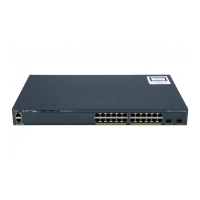1-8
Catalyst 2960 and 2960-S Switches Software Configuration Guide, Release 15.0(1)SE
OL-26520-01
Chapter 1 Overview
Features
• LLDP-MED network-policy profile time, length, value (TLV) for creating a profile for voice and
voice-signalling by specifying the values for VLAN, class of service (CoS), differentiated services
code point (DSCP), and tagging mode
Note Supported on all images in Cisco IOS Release 12.2(55)SE and later.
• Support for including a hostname in the option 12 field of DHCPDISCOVER packets. This provides
identical configuration files to be sent by using the DHCP protocol
• DHCP Snooping enhancement to support the selection of a fixed string-based format for the
circuit-id sub-option of the Option 82 DHCP field
• Increased support for LLPD-MED by allowing the switch to grant power to the power device (PD),
based on the power policy TLV request
• USB mini-Type B console port in addition to the standard RJ-45 console port. Console input is
active on only one port at a time. (Catalyst 2960-S only)
• USB Type A port for external Cisco USB flash memory devices (thumb drives or USB keys). You
can use standard Cisco CLI commands to read, write, erase, copy, or boot from the flash memory.
(Catalyst 2960-S only)
Availability and Redundancy Features
• Automatic stack master re-election for replacing stack masters that become unavailable (failover
support)
The newly elected stack master begins accepting Layer 2 traffic in less than 1 second and Layer 3
traffic between 3 to 5 seconds.
• Cross-stack EtherChannel for providing redundant links across the switch stack
• UniDirectional Link Detection (UDLD) and aggressive UDLD for detecting and disabling
unidirectional links on fiber-optic interfaces caused by incorrect fiber-optic wiring or port faults
• IEEE 802.1D Spanning Tree Protocol (STP) for redundant backbone connections and loop-free
networks. STP has these features:
–
Up to 128 spanning-tree instances supported
Note Up to 64 spanning-tree instances are supported when the switch is running the LAN Lite
image.
–
Per-VLAN spanning-tree plus (PVST+) for load balancing across VLANs
–
Rapid PVST+ for load balancing across VLANs and providing rapid convergence of
spanning-tree instances
–
UplinkFast, cross-stack UplinkFast, and BackboneFast for fast convergence after a
spanning-tree topology change and for achieving load balancing between redundant uplinks,
including Gigabit uplinks and cross-stack Gigabit uplinks
• IEEE 802.1s Multiple Spanning Tree Protocol (MSTP) for grouping VLANs into a spanning-tree
instance and for providing multiple forwarding paths for data traffic and load balancing and rapid
per-VLAN Spanning-Tree plus (rapid-PVST+) based on the IEEE 802.1w Rapid Spanning Tree
Protocol (RSTP) for rapid convergence of the spanning tree by immediately changing root and
designated ports to the forwarding state

